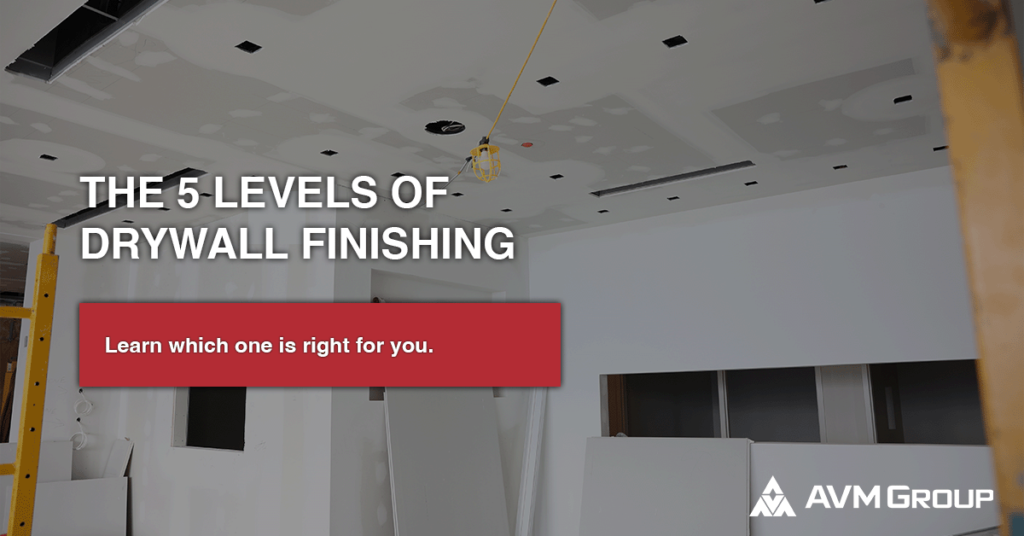*This post is part of a much larger pillar blog: The Complete Commercial Drywall Guide
Table of Contents
ToggleIntroduction to Drywall Finishing
When completing a project, understanding the desired aesthetic of the space and how it relates to the five degrees of finish you may achieve with gypsum board surfaces is crucial before completing the drywall on any job.
This is because you need to plan for the materials, labor, and time required.
In this blog, we’ll be discussing the 5 levels of drywall finish, and what applications they’re typically used for.
Before we begin, here’s a few important things to note:
- If your sole goal is to have joints completely hidden, you should opt for a trowel plaster finish.
- Level 0 through 4 are about covering the joint, and level 5 skim is mostly for aesthetics.
Level 0 Drywall Finishing
What is a Level 0 Gypsum Finish?
In Level 0, Gypsum boards are simply left in their pre-installed state, without the need for adhesive, finishing, or accessories.
When would you use a Level 0 Gypsum Finish?
A Level 0 Gypsum Finish would primarily be used in spaces where aesthetics aren’t important at all, such as a garage.
Level 1 Drywall Finishing
What is a Level 1 Gypsum Finish?
In Level 1, tape is included into the joint compound at every joint and at all interior angles. Fasteners do not need to be covered, excess compound and tool marks are okay, and accessories are optional unless specifically included in the project documentation.
What would you use a Level 1 Gypsum Finish?
Usually, this level is designated for joint treatment in smoke barrier applications and places that are off limits to the general public.
Level 2 Drywall Finishing
What is a Level 2 Gypsum Finish?
Similar to level 1, this level of finish mandates that tape be included into the joint compound at all joints and interior angles. The joint tape is then wiped with a knife that leaves a thin coating of joint compound.
When would you use a Level 2 Gypsum Finish?
Typically, situations where gypsum panel materials are utilized as a substrate for tile specify this degree of drywall finishing. This coating can be utilized in storage, warehouses, garages, and other places where the look of the surface is not important.
GET THE LATEST INDUSTRY NEWS DELIVERED TO YOUR INBOX
Stay on the forefront of the construction industry with our weekly e-newsletter.
Level 3 Drywall Finishing
What is a Level 3 Gypsum Finish?
A level 3 gypsum finish requires that a separate additional coat of join compound is applied on top of a level 2 finish.
When would you use a Level 3 Gypsum Finish?
This gypsum board finish is often requested in sections that will get heavy or medium texture finishes prior to final painting or in places where high-duty commercial-grade wall coverings will be placed as the final decoration. Smooth wall designs or situations where light textures, non-continuous textures, or lightweight wall coverings will be used are not advised to use Level 3.
Level 4 Drywall Finishing
What is a Level 4 Gypsum Finish?
A level four finish is completed by applying two separate coats of joint compound over flat joints.
When would you use a Level 4 Gypsum Finish?
This level of finish is typically used in rooms where paint is the desired end finish. It is important to note however that at level 4, both natural lighting from a window and down lighting will reveal joint location.
Level 5 Drywall Finishing
What is a Level 5 Gypsum Finish?
Level 5 is a thin skim coat applied to the entire surface with joint compound before sanding.
This process gives your paper the same texture as the joint, making paint look better. The final surface finish is smooth and free of tool marks. With drywall, you still have a different texture between your joint and paper, regardless of the amount of primer. Paint always will absorb differently into the primer and the mud. Even with a level 5 finish, joints may be seen at times.
When would you use a Level 5 Gypsum Finish?
Gypsum board finishing Level 5 is generally requested in appearance areas where smooth wall designs are embellished with glossy or ornamental finishes, dark/deep-tone paints, or non-flat paints, as well as in locations where there are challenging lighting situations.
Again, it’s important to note that even with a level 5 drywall finish, you may still see joints provided light hits the walls at certain angles.
Closing
We hope this blog shed some light on the differences in gypsum finishes, and helped you make an informed decision for your next project.
Learn more about commercial drywall by clicking this link.



